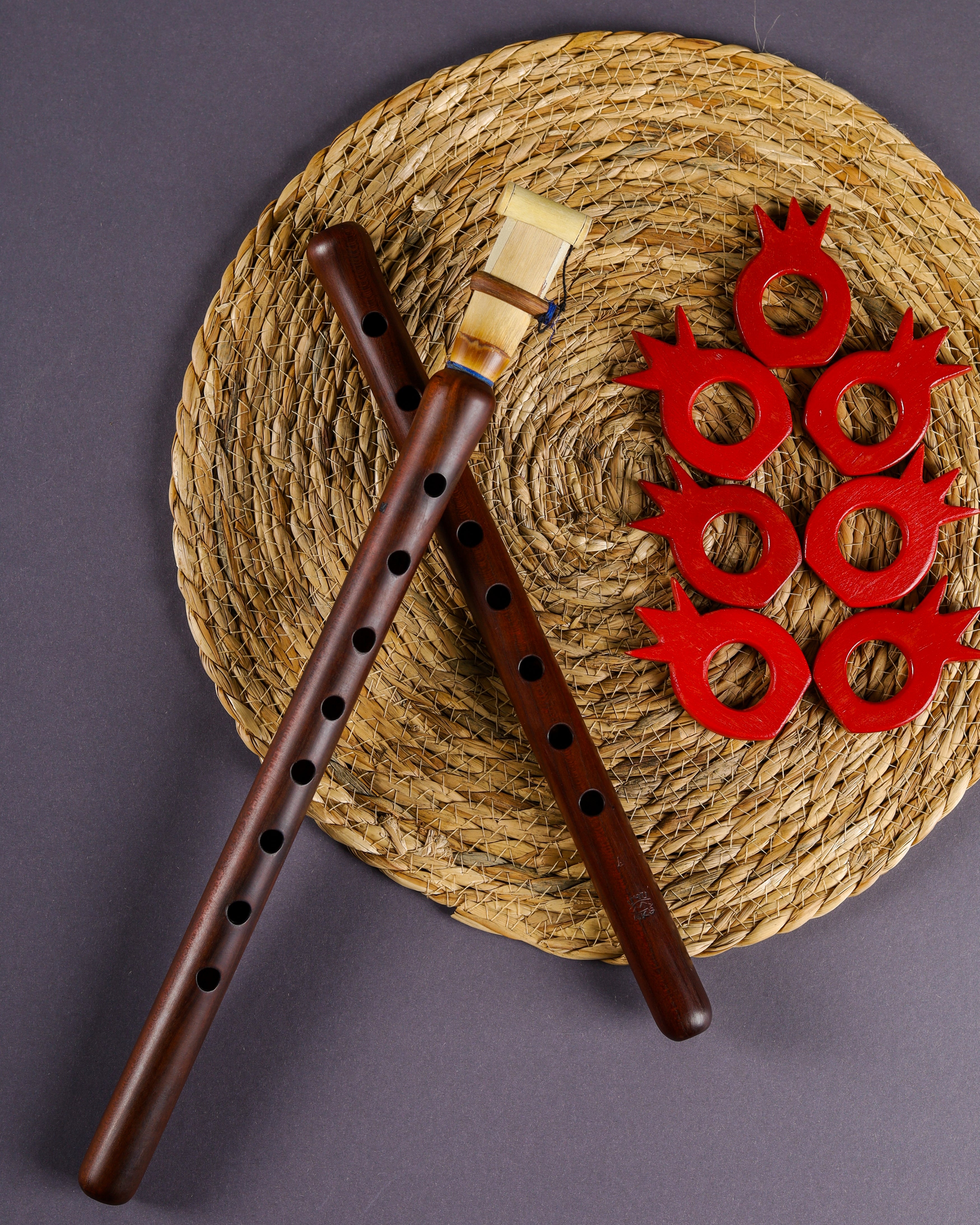Although many Duduk players have gained fame as soloists, it can also traditionally be played in a duo. The lead player is accompanied by a second Duduk player who holds the drone, called "dam" in Armenian. "Playing the drone" consists of holding a long and continuous note, often that of the tonic or dominant, to provide the sound background and invite the main instrument to express itself through its melody. The player holding the "dam" is called "damkash" and uses the technique of circular breathing to play a long-lasting note without interruption.
In addition to the lead player and the damkash, a third Duduk can be present to enrich the musical background by playing the main piece episodically, but in the third, fifth, or octave. Although most Duduk groups consist of three musicians, it is not uncommon to see groups of four, five, six, or more Duduks, including bass Duduks and additional drones. Each musician has a unique part, one playing the first voice in the third, another the second in the fifth, then another the third in the octave, and so on.
Groups exclusively composed of Duduks are often formed to showcase the mastery and complexity of the Duduk while playing pieces where the moving sound of the instrument is highlighted. However, the Duduk can also be accompanied by other instruments and percussions to play pieces in broader and more rhythmic styles, with greater melodic and musical richness.
Duduk-only bands are often formed to showcase mastery of the complexity of the Duduk while playing pieces where the soulful sound of the instrument is highlighted. However, the Duduk can also be accompanied by other instruments and percussion to play pieces in larger and more rhythmic styles, with greater melodic and musical richness.
Duo, Trio and Quartet of Duduk
In the video below, you can hear several sequences of musical performances featuring two, three, or four Duduk players, where the first interprets the melodic line, while the second takes care of the "dam" (drone), and the others deploy harmonic melodic variations in the third or fifth octave. In all the interpretations, the continuity of the drone is noticed, which undergoes no interruption thanks to the use of circular breathing by the damkash.
As a duo
Duo Interpretation by Gevorg Dabaghyan
In threesome
Trio Interpretation by Georgy Minasov
In Quintet
Quintet Interpretation by Norayr Gapoyan
Large Ensembles
Group Interpretation by Gevorg Dabaghyan
Interpretation by Gevorg Dabaghyan, Kamo Seyranyan, Harutyun Chkolyan, Norayr Gapoyan....
Duduk in the traditional orchestra
In the traditional orchestra, the Duduk holds a privileged position. Indeed, within the orchestra, it's not uncommon to see four, five, or even six Duduks, but the particularity of this arrangement is that one Duduk player (often the most talented member of the group) is designated to play the solo parts in the composition. This player then takes center stage and performs a solo, always admired and applauded by the audience.
Interpretation of Gevorg Dabaghyan
Duduk in Symphonic Orchestra
Despite its traditional role in folk orchestras, the Duduk is frequently featured in Armenian symphonic orchestras. Its delicate sound gives it the ability to adapt to any musical context, while maintaining its uniqueness and Armenian authenticity.
Interpretation of Harutyun Chkolyan
Duduk accompanied by Dhol, Daf or Kopal
Below is a selection of performances that are highly faithful to the Duduk and its music. Traditionally, the Duduk is played in a duo, accompanied by a Dam, but the presence of a Dhol is also of great importance for establishing the rhythmic ambiance, especially in sung pieces.
Interpretation by Gevorg Dabaghyan
Interpretation by Norayr Gapoyan and Levon Harutyunyan
Interpretation by Edgar Hakobyan
Interpretation by Hovik Karapetyan
The Duduk and the Blul
Although they are not common, duets between the Duduk and the Blul generate significant interest amongst musicians. The warm and deep sound of the Duduk harmoniously complements the finesse and lightness of the Blul, creating a perfect musical symbiosis.
Interpretation by Levon Chatikyan and Avag Margaryan
The Duduk and the piano
In a Duduk and Piano duo, the Duduk can play the main melody with its distinctive and melancholic phrasing, while the Piano accompanies with harmonies and counter-melodies, or even develops improvisations in dialogue with the Duduk. This combination offers a range of complex emotions, from serenity to melancholy, and includes moments of energy and excitement.
Interpretation of Heghine Rapyan and Harutyun Chkolyan
Interpretation of Heghine Rapyan and Harutyun Chkolyan
Sources
Cover image: By John Buchan Telfer — The Crimea and Transcaucasia... Vol. I, 1876, p. 252 [485] [1], Public domain, https://commons.wikimedia.org/w/index.php?curid=32778819

